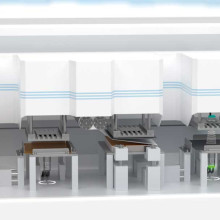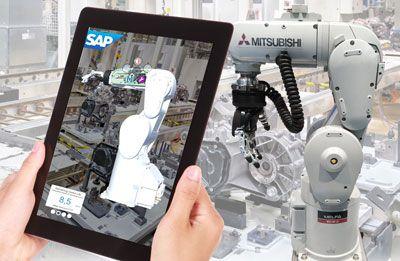 How far the coordination of production and the MES / ERP world can already be achieved on the way to Industry 4.0 is shown by the joint IoT solution from SAP and Mitsubishi Electric, Customers of the automation specialist can directly contact the cloud platform of the Partners connect SAP.
How far the coordination of production and the MES / ERP world can already be achieved on the way to Industry 4.0 is shown by the joint IoT solution from SAP and Mitsubishi Electric, Customers of the automation specialist can directly contact the cloud platform of the Partners connect SAP.
The tools and applications available there can leverage their production and plant data. Predictive maintenance and service engineer support through augmented reality are just two examples of the many ways to increase efficiency that comes with integration. On the part of the plant manufacturer, the new view of user usage data opens up innovative concepts for value creation in the service sector.
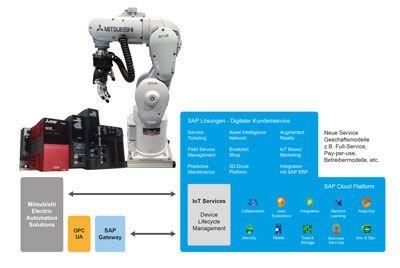 The showcase of the collaboration between Mitsubishi Electric and SAP is a Mitsubishi Electric robot with a digital image of the physical product in the SAP Cloud Platform. The digital twin enables the comprehensive analysis and use of all plant and process data by both the manufacturer and the operator.
The showcase of the collaboration between Mitsubishi Electric and SAP is a Mitsubishi Electric robot with a digital image of the physical product in the SAP Cloud Platform. The digital twin enables the comprehensive analysis and use of all plant and process data by both the manufacturer and the operator.
IT and production have to find each other
A huge obstacle to Industry 4.0 and the Internet of Things (IoT), which should make previously inaccessible data usable, is still the historical separation of the IT world and production technology or "Operational Technology" (OT). While data protection and confidentiality are the top priorities for information technology, availability is the be-all and end-all in production. With the connection of previously closed production systems to the Internet and the new responsibility of IT for the management and protection of production resources, both sides have to find each other in order to work productively and efficiently in the age of IoT.
 Graphic HMI operator terminals for industrial automation
Graphic HMI operator terminals for industrial automation
SAP on the IT side and Mitsubishi Electric on the OT side first had to agree on common definitions of terms in order to be able to connect the Mitsubishi Electric automation world with its PLCs, robots, motion controllers and CNC controls to the SAP Cloud Platform.
Centralized data transfer
The Mitsubishi Electric automation platform provides device-wide visibility. This means that all data can be accessed from a central point in production. It is also very easy to exchange data with other automation components such as RFID readers, sensors or other control systems. All data is transferred centrally to the SAP IoT Services of the SAP Cloud Platform.
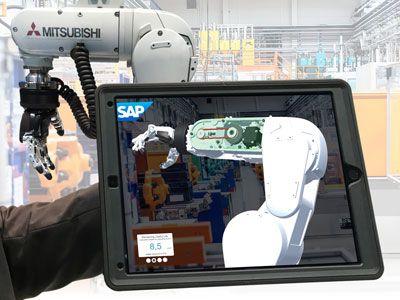 The SAP Cloud Platform takes over the data for storage in a Big Data Lake in order to make it available to all applications and services of the Cloud Platform. Short-term data, for example the time series of the past four weeks, are stored in an in-memory database to enable quick access. The historical data is managed in cheaper classic big data storage. The management of large amounts of data is offered as a service (PaaS) via the SAP Cloud Platform, i. H. the user does not have to set up and operate a big data architecture in their own data center.
The SAP Cloud Platform takes over the data for storage in a Big Data Lake in order to make it available to all applications and services of the Cloud Platform. Short-term data, for example the time series of the past four weeks, are stored in an in-memory database to enable quick access. The historical data is managed in cheaper classic big data storage. The management of large amounts of data is offered as a service (PaaS) via the SAP Cloud Platform, i. H. the user does not have to set up and operate a big data architecture in their own data center.
Immediate IT connection of production
The special feature and significant simplification of the automation solution is the direct connection to production without using others Gateways. The automation company's proprietary technology and the circumvention of Windows-based systems ensure a high level of security (cyber security) for the systems. Alternatively and with other manufacturers, the connection is made with a software gateway OPC UA.
For the connection to SAP is on the Programming platform “iQ Works“Mitsubishi Electric defined a data structure for the data to be sent to the SAP Cloud Platform. 1000 measured values were given for the showcase; however, the size of the data structure can be freely selected. Now only the IP address of the Cloud Platform IoT Services and the login data (name, password) need to be parameterized on the communication interface C Application Server. Then the data is exchanged continuously, typically every 500 ms. Of course, other data structures with different transmission intervals can be defined. The event-controlled transmission of individual data is possible in parallel.
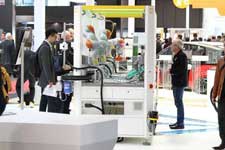 Digital twin builds a bridge over systems installed around the world
Digital twin builds a bridge over systems installed around the world
In the cloud, this information is distributed among the different applications. The services offered here include analytical tools for evaluating error codes, machine learning services, development services for cross-device development of your own applications, and integration services for the local SAP ERP systems. Subsequently, the evaluated data are simply transferred back into a predefined data structure to the automation world.
The data structures for sending and receiving are defined jointly by the IT and OT teams. In the case of the robot cell, only a sufficiently large data space was defined and gradually filled with life. The definition of the measured values and properties was carried out by means of a data table divided in the cloud. The exchanged values can be checked and visualized directly with the tools of IoT Services. You distribute the data to the immediate-use remote monitoring, predictive maintenance, dashboard, and more.
Digital twin opens up business models
 The digital twin is the point at which all information about an asset from the CAD data to the live cycle information is brought together. Parameters, programs and libraries from the automation devices can also be stored here. This enables automated data exchange from construction to simulation. “The 'digital twin' is actually old hat,” says Adrian Langlouis, Solution Architect, Discrete Industries at SAP. "Manufacturers of intelligent devices use the digital image from their service module for service, and system operators use their maintenance module to define the maintenance intervals." So far, manufacturers and operators have had a one-sided view of the processes in their own modules; in the future they should share their content with each other.
The digital twin is the point at which all information about an asset from the CAD data to the live cycle information is brought together. Parameters, programs and libraries from the automation devices can also be stored here. This enables automated data exchange from construction to simulation. “The 'digital twin' is actually old hat,” says Adrian Langlouis, Solution Architect, Discrete Industries at SAP. "Manufacturers of intelligent devices use the digital image from their service module for service, and system operators use their maintenance module to define the maintenance intervals." So far, manufacturers and operators have had a one-sided view of the processes in their own modules; in the future they should share their content with each other.
Modern digital twin
"A modern digital twin is created when information about the physical product is exchanged between all parties on a cloud platform such as the SAP Asset Intelligence Network. Manufacturers, service partners and plant operators each receive an individualized view of the plant, "explains Adrian Langlouis.
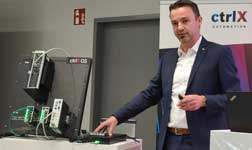 Ctrlx automation platform | Innovations & further developments
Ctrlx automation platform | Innovations & further developments
For the manufacturer, using the digital twin in the asset network is a service portal where he can provide documentation, 3D models, maintenance instructions or health scores of the asset, and set up self-service capabilities for the customer, such as ordering directly Spare parts by selection on the 3D model.
Plant operators receive a uniform view of the digital machine file and, if required, can create a service ticket directly in the customer portal and order spare parts from the original manufacturer or via a connected 3D print marketplace from SAP. Optimization potential opens up by waiving the stockpile of printable slow-movers.
Optimization of maintenance with predictive maintenance
 By analyzing historical machine data from the control and sensor systems, deviations and error patterns can be detected and used to monitor systems or optimize maintenance cycles. The SAP Predictive Maintenance and Service solution delivers the necessary data models and algorithms to model and monitor assets through regularly calculated and visualized health scores and integration with SAP maintenance and service solutions.
By analyzing historical machine data from the control and sensor systems, deviations and error patterns can be detected and used to monitor systems or optimize maintenance cycles. The SAP Predictive Maintenance and Service solution delivers the necessary data models and algorithms to model and monitor assets through regularly calculated and visualized health scores and integration with SAP maintenance and service solutions.
Manufacturers with a variety of identical machines at the customer's sample size can deliver a particularly solid data for the Health Score and either offer self-monitoring and predictive maintenance as a service or facilitate the maintenance of the customer. In any case, maintenance cycles can be optimized and, in some cases, considerable cost savings. As far as the database is concerned, maintenance on the part of the operator and service on the manufacturer side are nothing more than two sides of the same coin.
Given the shortage of skilled workers in industry, service organizations or maintenance departments find it hard when experienced employees retire or leave the company. The use of augmented reality (AR) for maintenance work offers a way out of this dilemma. If you visualize maintenance instructions step by step via a 3D model with a data glasses, more complex maintenance tasks can also be assigned to inexperienced employees. If support is still required, an experienced technician can be connected via video and support the colleague on site at work.
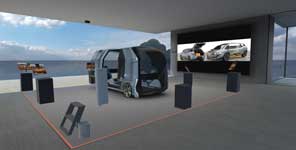 metaverse | My first experience with the Iguversum
metaverse | My first experience with the Iguversum
At the SAP and Mitsubishi Electric showcase, the technician can place a mobile device, such as an industrial tablet, directly on top of the robot, and get the 3D model in front of the physical product. The 3D model shows him which part to swap and how to do it. AR technology can greatly simplify and optimize the work of the service technician.
Equipment as a Service (EaaS)
With full connectivity to device data and remote monitoring, plant builders can position themselves as full-service providers, providing their entire services in service-level agreements and assuming responsibility for plant maintenance and availability. While manufacturing companies can outsource such unproductive activities and focus on value-added activities, the manufacturer benefits from customer loyalty and better continuity and sustainability of its sales streams.
 On the basis of universal data transparency, if you think it through, new business models can be developed away from device sales and towards service offerings such as “pay-per-use”. The machine or system remains the property and responsibility of the manufacturer, who calculates the performance or output based on a metric for the customer. Existing examples from the industry are the number of pages printed on printing machines, operating hours on construction equipment and the amount of compressed air compressors.
On the basis of universal data transparency, if you think it through, new business models can be developed away from device sales and towards service offerings such as “pay-per-use”. The machine or system remains the property and responsibility of the manufacturer, who calculates the performance or output based on a metric for the customer. Existing examples from the industry are the number of pages printed on printing machines, operating hours on construction equipment and the amount of compressed air compressors.
"I see a very clear business model in the fact that customers may not buy the system anymore, because the investment is too high for them. Instead, they use the service, which is billed according to a pay-per-use model, where the customer generates added value. This is an enormous potential for us, our customers and their customers to set up new business models, "says Thomas Lantermann, Senior Solution Consultant at Mitsubishi Electric, describing his vision. The customer receives an all-inclusive package with guaranteed availability under Service Level Agreements (SLAs).
You might also be interested in...

Artificial Intelligence | trends and developments
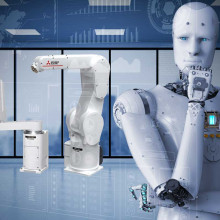
Predictive maintenance for robotics, machines and systems

Mitsubishi Electric | Automating the World
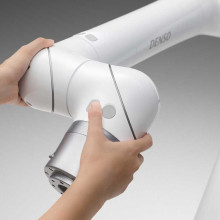
Cobot | Discover collaborative robots as a new employee

Intelligent CNC control for machine tools
